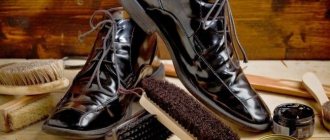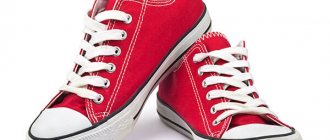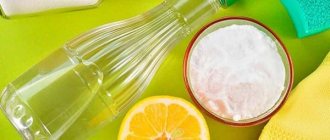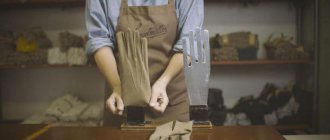Wool
Woolen clothing and products made from mixed fibers containing more than 50% wool are highly demanding in terms of care.
When washing, you need to use products that have a reduced concentration of alkalis. It is better to wash entirely woolen clothes carefully by hand at low temperatures (+30) without prolonged soaking, without twisting and, if possible, without deforming. If the clothing material contains special fiber, it can be machine washed by selecting the “Wool” mode. In this case, before washing, the clothes must be turned inside out and then placed in a laundry bag.
Drying woolen products is only permissible in a straightened state on a horizontal surface. This will avoid deformation of the product. It is required to maintain a significant distance from heating devices and direct rays of the sun.
Ironing woolen clothes should be done through a damp cloth or only with steam.
Shoe care
Shoes will last a long time if you treat them correctly. Do not remove shoes by pressing down on the heel with the other foot, as this may deform the heel. Put on your shoes using a special horn.
After each time you go outside, clean your shoes from dirt and then lubricate them with shoe polish.
Shoe care products must be selected based on color and material and applied only to clean shoes.
It is best to store shoes in transparent boxes. This makes it easier to find the right pair and, in addition, the boxes will protect the shoes from dust and moisture.
Synthetics
Synthetic materials are characterized by great diversity.
Some of them have original operating requirements. For this reason, it is important to study the manufacturer's information on care conditions. The general rule for washing synthetic materials is low temperature (30 to 40) and an all-purpose detergent. Drying should be carried out in a straightened state. Ironing requires low temperature. Clothes made from artificial (acetate or viscose) silk should not be sprayed with water during ironing, as drops lead to streaks. For a similar reason, it is unacceptable to turn off the steam supply if the iron does not have an anti-drip system. When ironing at a low temperature is used, steam often does not have time to form, as a result of which water sometimes simply flows out of the holes in the soleplate of the iron, falling on the fabric and forming stains.
Cleaning - features and recommendations
Any item, no matter how carefully it is worn, still gets dirty, and therefore it is important to understand how to properly rid wardrobe items of dirt and the unpleasant odor that accompanies them. We'll talk about this later.
Elimination of odors
Universal products that can remove the most persistent aromas are regular (non-iodized) salt and baking soda. They are used in different ways.
Before washing:
- Make a solution based on any of the named components (take a glass of it and add four more slightly cooled boiling water). Stir until the crystals are completely dissolved.
- Combine the resulting mixture with 4 or 5 liters of cold water. Soak the item.
- After about an hour, wash as usual.
- Rinse well.
- Air dry.
If you want it faster, just add up to 2 tbsp. salt or soda into the powder cuvette, but this option is not able to eliminate the strong amber. With this and many other means you can easily and quickly remove the smell of gasoline from clothes.
Vodka will help remove the smell of sweat from non-fading items. Pour it into a spray bottle and spray problem areas (armpits, collar). Send the item to dry in fresh air. You can find information on how to get rid of sweat odor on our website.
Alcohol with vodka also allows you to eliminate questionable odors from shoes - just wipe the inner surface of your shoes or boots with a swab soaked in alcohol. Moisten more. After a few hours, wipe with a paper towel and dry at room temperature. By the way, these same products can remove the smell of mold from clothes.
Odors left by animals are very difficult to remove. Vinegar essence will help you here. Dilute it in a ratio of 1 to 5 with clean water. Spray the area of clothing or shoes marked by the cat with the prepared product. Wait 15 minutes. Next, you should wash the wardrobe item as usual, and simply take the shoes out into the fresh air.
Our detailed article will tell you how to get rid of the persistent second-hand smell from things.
The cold removes odors quite well. In winter, the item is placed outside, and in summer, the refrigerator should be used for the same purpose. This option is also suitable for outerwear.
Fighting stains, secrets of removal
The most important thing in eliminating such contamination is a quick response. Don't waste time and start working immediately. Most fresh stains can be easily removed, but once dry they remain forever.
Here it is necessary to understand the nature of this or that soiling substance:
- sweat and blood contain protein structures;
- juices, wine - pigments and alcohol;
- food products - mainly fats.
In the first case, it is better to use cool water and regular soap. Wash the stain and rinse it thoroughly. Repeat the procedure if necessary.
Removing complex stains such as those caused by cosmetics has many nuances. You will learn how to remove foundation stains from our article.
It is better to remove red wine and other strongly colored drinks from light-colored fabrics with table vinegar or lemon juice. Wet the problem area generously until it discolors. Bright fabrics are sprinkled with fine salt or treated with ammonia. Old wine stains are dissolved with pure alcohol. You can find tips on how to permanently remove red wine stains here.
Fatty stains cannot be washed off with hot water - use only cold water and regular dish soap. Leave the foam for five minutes and rinse the item. It is also acceptable to use gasoline or white spirit. For example, you can learn how to remove machine oil stains from the article on our website.
Removing food stains also has its own characteristics. You will learn how to remove coffee from clothes, as well as chocolate stains, by reading our article.
Important: before cleaning a stain, study the tag of the damaged clothing - all the information regarding care is there.
Items with heavy stains are soaked for several hours using a certain amount of suitable powder before being put into the machine. This is done, for example, with grass stains.
Remember the general rules:
- While the stain is still visible, the item cannot be dried;
- blot fresh dirt rather than rub it;
- Before using any homemade or store-bought product, test it on an inconspicuous area of clothing.
The nuances of washing various materials
Linen and cotton get rid of all impurities in water heated to +40 °C. Higher temperatures cause shrinkage of the material. It is useful to starch things a little, they will become denser and retain their shape longer, and in this case the dirt will be absorbed worse. Some materials only require dry cleaning.
Silk does not tolerate high temperatures, sunlight, acidic and equally alkaline environments. It requires hand washing in soft water at room temperature and special powders. The fabric is not wrung out or rubbed. These recommendations are also relevant for artificial silk.
Important: lace items are dried without clothespins, which can damage the thin fabric.
It is not advisable to wash woolen items; they should be sent to dry cleaning. If there are no options, then use lukewarm (up to +20 °C) water at all stages. Heavily soiled items are soaked in a solution of ordinary soap. During the rinsing process, add a little ammonia.
Wherein:
- for light wool, peroxide is poured into the water at the last stage (1 tablespoon per liter);
- for dark - vinegar (1 tbsp for the entire volume of liquid).
Before drying, clothes are turned inside out and laid out horizontally. If you are using a machine, select the hand wash mode.
Items knitted from mohair or angora wool are washed in a shampoo solution. The optimal temperature is +35 °C. Things are not rubbed, but gently wrung out in water. The nuances of washing knitted items can be found on our website.
White outer jersey (and equally underwear) may turn yellow. To prevent this from happening, use a weak solution of powder with ammonia. Colored clothes are rinsed in water and vinegar.
Synthetics are no different from capriciousness; here it is only important to observe the temperature regime. +50 °C is optimal. You will find how to wash viscose on our website.
Lace is cleaned with soft compounds diluted with warm water. You can’t rub it, it’s better to use a sponge. Soak heavily soiled items for 1-2 hours in a saline solution (1 tsp per 6 liters).
Whitening
In order for the item to return to its original color, it is more advisable to use high-quality store-bought products. At the same time, it is important not to overload the machine - this way the product penetrates the fibers better and, therefore, the dirt is washed out more efficiently.
Bleach is now produced in two main types. Some contain chlorine, while others contain oxygen compounds. The former are more aggressive, the latter more delicate. To increase the effectiveness of their use, we recommend adding a little soda (1 tablespoon per 4 liters of water).
How to bleach white linen at home, you can read in our article.
Lemon juice should be used to restore white shoes. Squeeze it out of the citrus, soak a cotton pad in the liquid and wipe. Then wait a quarter of an hour and rinse with clean water.
Viscose
Viscose clothing is incompatible with high temperatures and intense spinning. Since the raw material of viscose fibers is cellulose, when wet they become weak and deformed. Recognizing viscose with the naked eye is sometimes difficult. After all, such fabric is often given the appearance of cotton, silk, linen or wool by imparting certain characteristics to the fibers (matte or shiny surface, crimp and thickness). For this reason, you should always read the fabric composition indicated on the label.
The nuances of choosing a wardrobe
Everyday outfits should form a single stylistic and color ensemble. All items are selected strictly according to size, every detail matters. Baggy items look sloppy, and things that are too small look funny.
Pastel shades will suit dark skin and dark hair, while bright shades, on the contrary, will suit light hair. Accessories are selected in one color - you cannot wear brown shoes with a black belt, etc.
For thin people, soft knitwear, tight fit and printed, embossed fabrics are suitable. If you are overweight, you should choose thick textiles in dark shades that hold their shape well. Vertical thin stripes are preferred.
The above helpful tips will help you take proper care of your clothes. The articles posted on our website will reveal all the intricacies of maintaining, washing, ironing and repairing things. Read them and you can avoid many annoying mistakes.
Membrane fabrics
Items made from such materials should be washed at low temperatures (from 30 to 40) on a delicate cycle or by hand (recommended). It is highly undesirable to use washing powder, as it clogs membrane pores. It is preferable to use special detergents or liquid soap against minor stains. Dry cleaning, bleaching and boiling of clothes made of membrane fabric is unacceptable, since it entails a loss of the protective qualities of these materials. Drying should be carried out in a straightened state at room temperatures. Ironing of this category of clothing is not permitted.
How to properly store clothes?
Very often, during wear, sweaters stretch, and “bubbles” appear on the knees of tights and jeans, and the shoulders of coats and suits become deformed.
How to store things to avoid this?
To store clothes - dresses, blouses, shirts, jackets - you need to use hangers. This way they will retain their shape. You should not hang several dresses, blouses or shirts on one hanger at once, they will wrinkle. For each item, it is better to choose suitable hangers. Their width should correspond to the width of the shoulders of the garment.
Skirts should be stored on hangers with clothespins. Trousers folded in half should be hung on a crossbar in the closet.
Sweaters, cardigans, and woolen items on hangers will stretch and, as a result, lose their shape. Therefore, it is better to fold them and store them on a shelf. Jeans can also be stored folded on a shelf.
When worn, some items become covered in pellets and lose their attractive appearance. This is a process that is related to the characteristics of the fiber. But they are easy to get rid of using a special machine. It is compact and runs on batteries. It is easy to clean - you just need to remove the tank and throw away its contents. After that you can continue to use it.
An indispensable means of caring for clothes is a cleaning roller. It can be used to clean clothes from dust, small debris, and pet hair.
After the end of the season, things need to be put away for storage. It is better to store coats, jackets, and items made from expensive fabrics in cases. They will protect them from dust.











